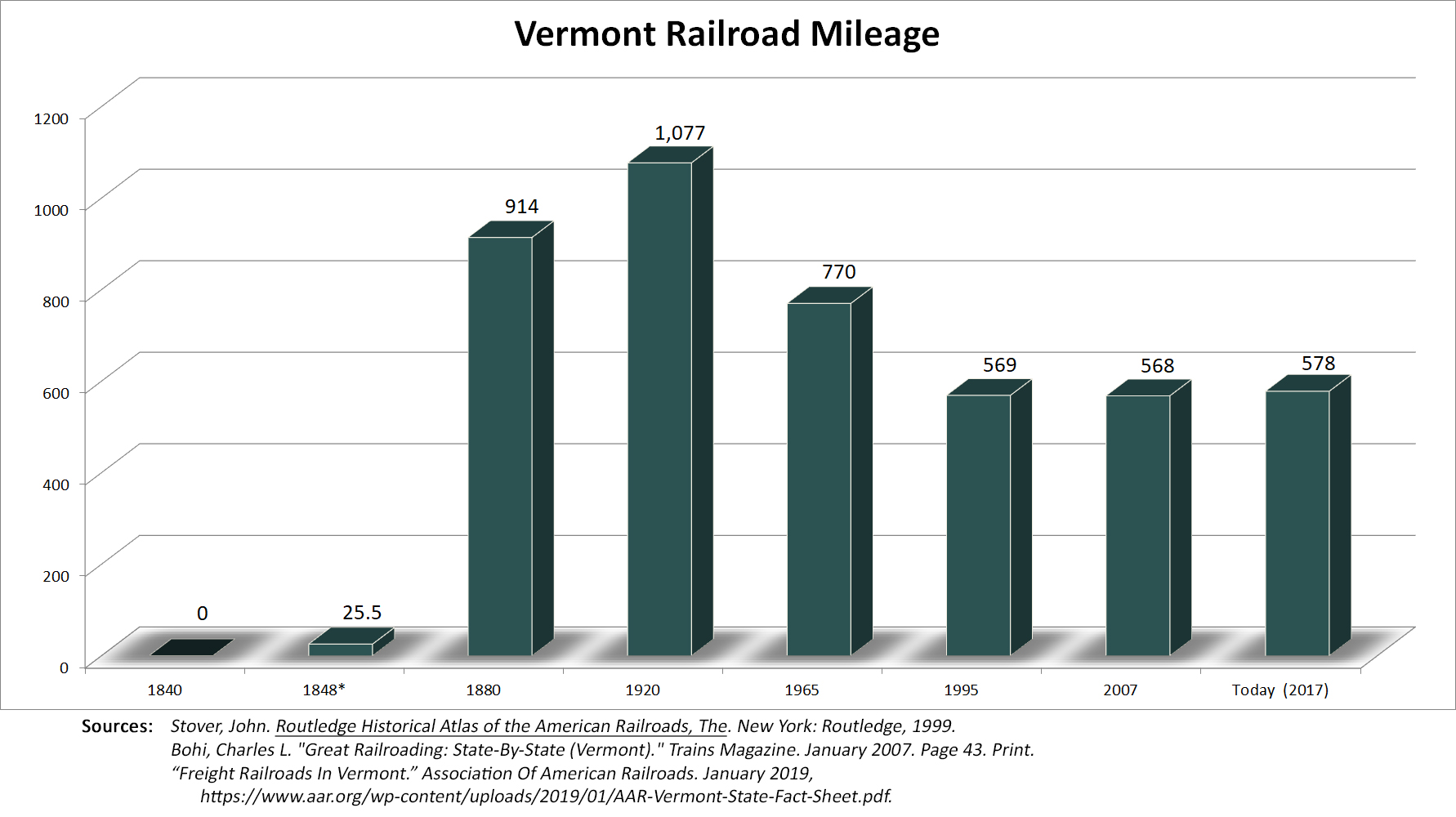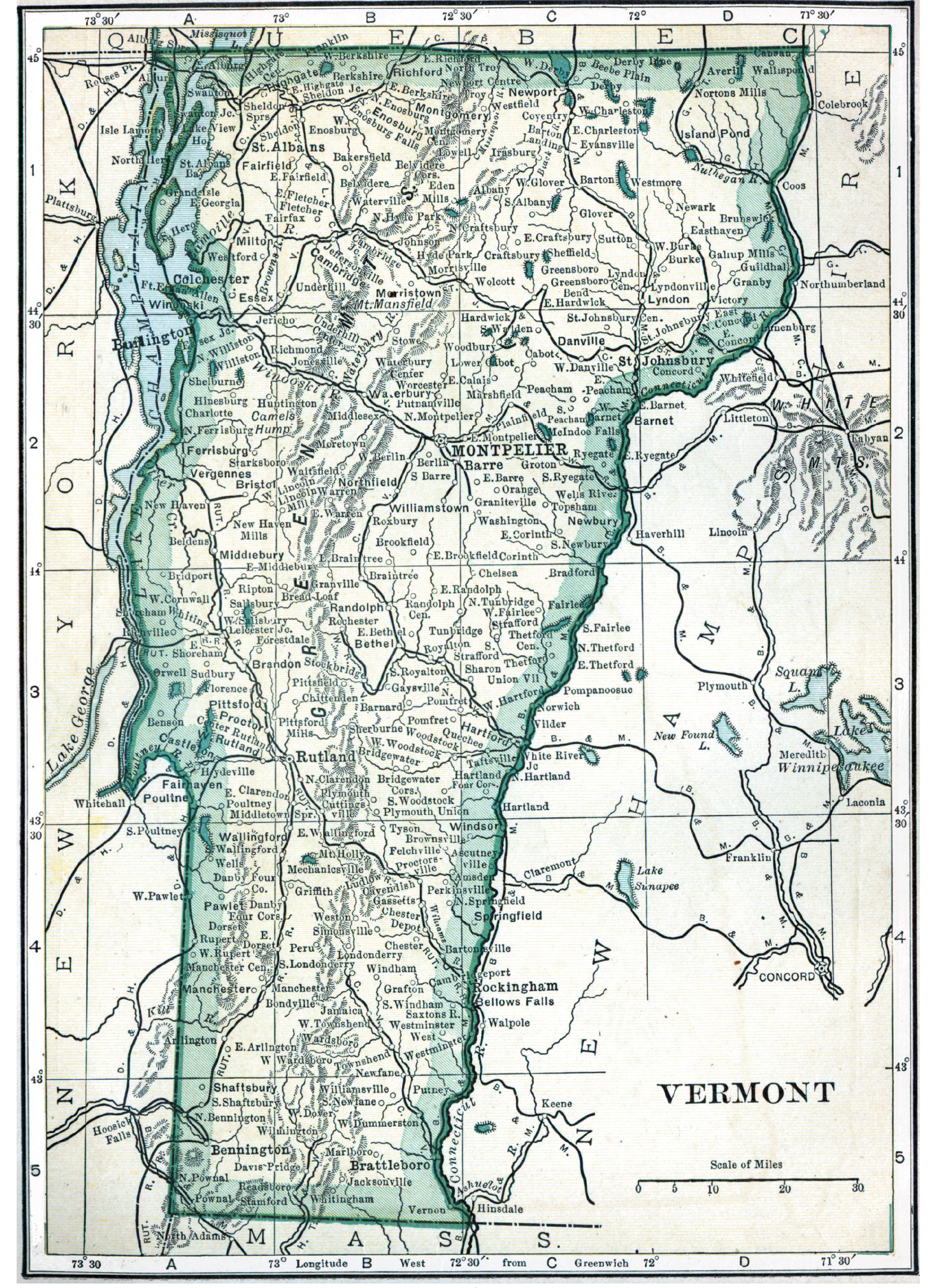- Home ›
- The States ›
- Vermont
Vermont Railroads: State Map, History, Abandoned Lines
Last revised: September 7, 2024
By: Adam Burns
While Vermont railroads once featured celebrated lines like the Rutland
Railroad, Boston & Maine, Central Vermont, and Delaware & Hudson.
For many years, Vermont carried a similar statistic that most New England states would rather not have; it no longer enjoyed Class I rail service.
History
However, that changed in 2020 when two subsequent events took place; in June Canadian Pacific acquired the Central Maine & Quebec while that same year CSX Transportation announced it was purchasing Pan Am Railways.
After more than 40 years of not having Class I service, it appears Vermont gained back two in the span of a single year.
However, how long both roads continue to operate the entirety of these smaller systems they acquired remains anyone guess.
In addition to providing freight service, the Vermont Railway also operates the Green Mountain Railroad, a popular tourist attraction offering guests spectacular views of the Vermont countryside.
If you are interested in visiting New England this a fantastic way to see its splendor, especially during the fall.
Photos
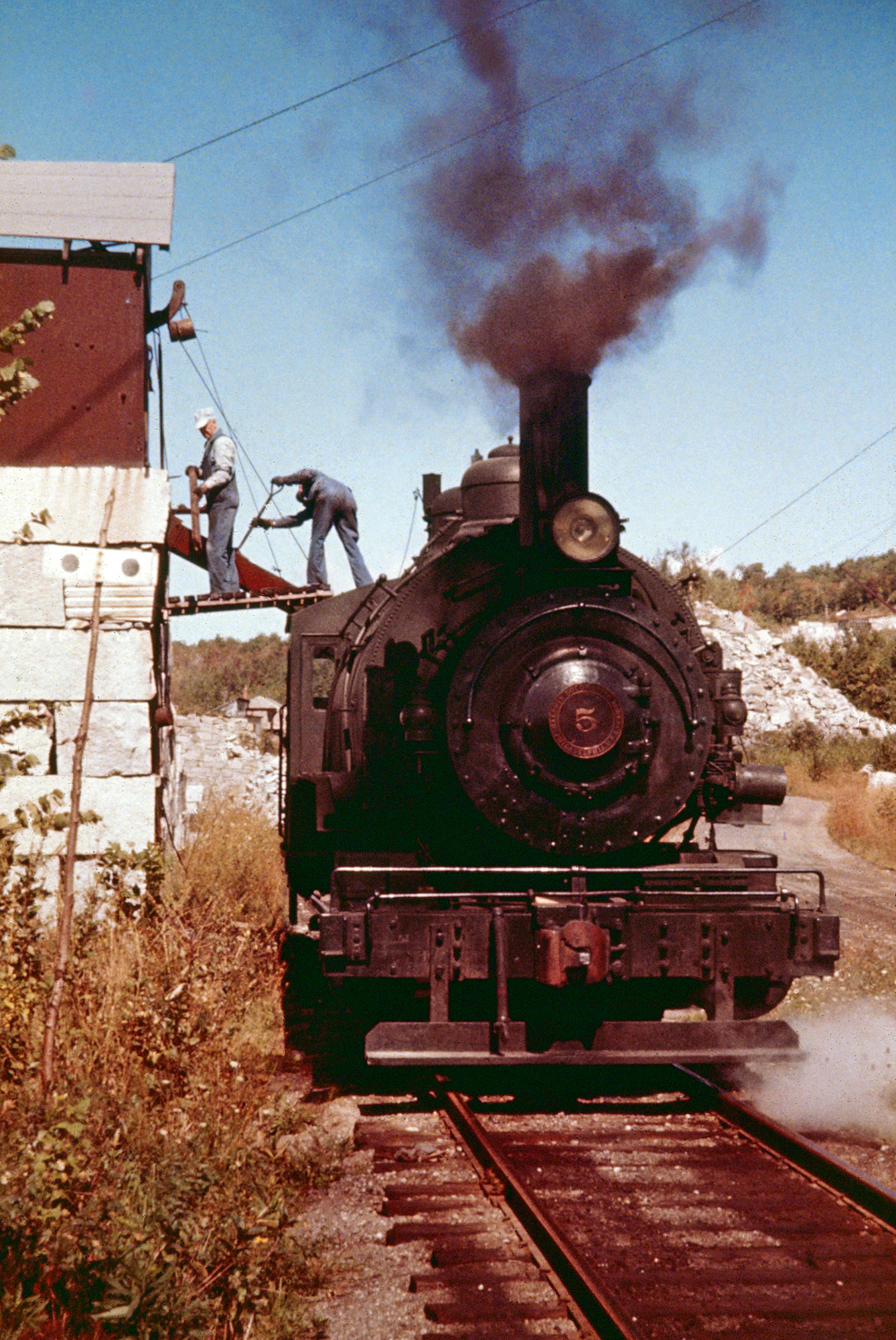 Rock of Ages 0-6-2T #5 takes on coal in Graniteville, Vermont during the 1940s. Philip Hastings photo. American-Rails.com collection.
Rock of Ages 0-6-2T #5 takes on coal in Graniteville, Vermont during the 1940s. Philip Hastings photo. American-Rails.com collection.Historically, Vermont was the home of the Rutland; a fabled New England carrier that shutdown in 1961. The railroad offered photographers bucolic settings of a local freights passing through small towns during simpler times.
It was once a common sight to catch trains loading milk at the depot when this product regularly traveled by train. Today, much of the old Rutland remains in use under the Vermont Railway although the quiet charm has long since passed.
Vermont railroads date back to 1843 when the Vermont Central Railroad was chartered to connect Windsor with Burlington, a distance of roughly 103 miles.
The first segment was completed in June of 1848 connecting White River Junction with Bethel, and the entire line was opened on December 31st, 1849.
The railroad eventually became part of the Central Vermont Railway, a fabled New England line that eventually connected northern/central Vermont with central Massachusetts, reaching as far south as New London, Connecticut.
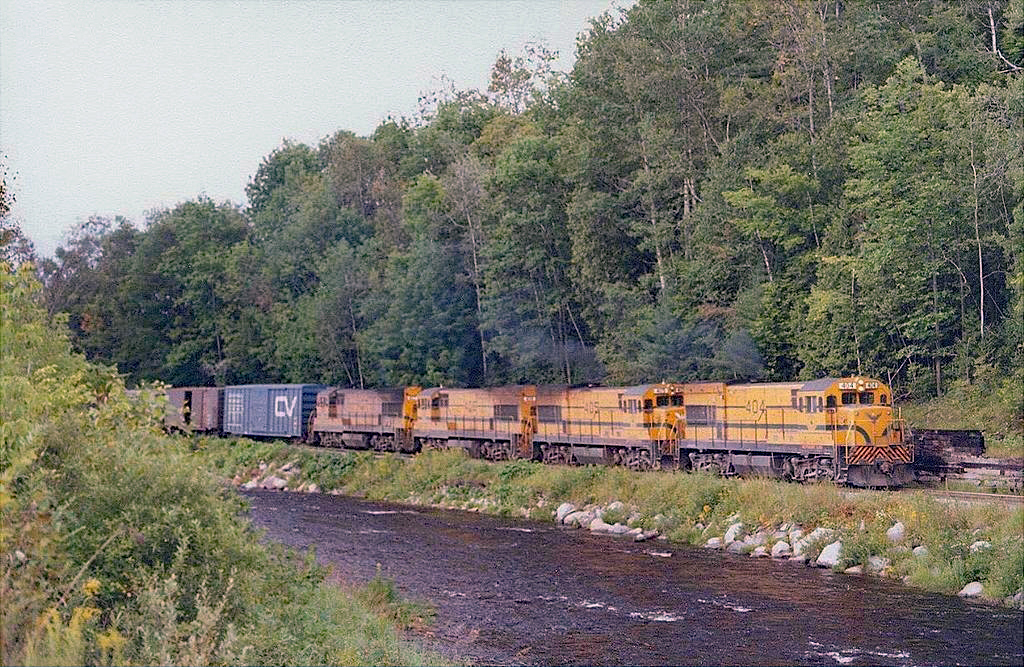 A quartet of Maine Central U18B "Baby Boats" are on the Mountain Division near East St. Johnsbury, Vermont on August 6, 1981. Doug Kroll photo.
A quartet of Maine Central U18B "Baby Boats" are on the Mountain Division near East St. Johnsbury, Vermont on August 6, 1981. Doug Kroll photo.At the railroad's height of independence it controlled the Rutland Railroad but bankruptcy in the late 19th century forced it to lose control of the nearby company.
Soon after in the early 20th century the Central Vermont came under the control of the Grand Trunk Railway, a Canadian National subsidiary.
It remained under CN control until 1995 when it was sold to the New England Central Railroad, an important shortline system in the region.
While Vermont was home to railroads like the B&M, Central Vermont, and D&H perhaps its most legendary railroad was the Rutland Railroad, which even named itself after the state, The Green Mountain Gateway.
Current Railroads
- Vermont Railway
- New Hampshire Central Railroad
- CSX Transportation (ex-Pan Am)
- St. Lawrence & Atlantic Railway
- New England Central Railroad
State Mileage Chart
First Railroad
* By New England standards, Vermont's first railroad was not constructed until relatively late when the Vermont Central Rail Road (VCRR) was incorporated by the state in late 1843.
The road's purpose, conceived by Charles Paine, was to not only link Vermont with the rest of New England but also transport its agriculture (notably cheese and milk) and marble to market. Construction was launched in 1845 and the first section, about 25.5 miles, opened between Bethel, Vermont and White River Junction in the summer of 1848.
Throughout the 19th century the company continued to expand and grow, becoming one of the region's largest. Unfortunately, it became overextended and fell into bankruptcy in 1896, emerging two years later in 1898 as the Central Vermont Railway. The CV became a Canadian National subsidiary for decades until it was spun-off in 1995. The original route remains in regular service today.
Additionally, passenger service can still be found in the Green Mountain State with Amtrak operating the Vermonter between St. Albans and Washington D.C. and the Ethan Allen Express between Rutland and New York City.
State Map
Historically, Vermont was never home
to any important or significant streamlined passenger trains although
lines like the Rutland, D&H, and Boston & Maine offered
local/regional service to the state.
Lastly, Vermont railroads offer some of the most spectacular excursion trains in the country with the Green Mountain Railroad offering splendid views of the Vermont countryside aboard one of its many tourist trains.
Also, be sure and visit the New England Transportation Museum to learn more about Vermont's railroad history.
Abandoned Lines
Like every state, Vermont has suffered its share of abandoned rail corridors; about 50% of its peak mileage has been removed since the 1920's.
However, this would have been much more had it not been for the state's foresight in purchasing left-for-dead corridors, like the Rutland.
At the time of the Rutland was in a precarious position; following its second strike in less than 10 years in 1960, it appeared the railroad would largely be scrapped.
This was made increasingly clear when the Interstate Commerce Commission ruled for total abandonment on January 29th, 1963.
In August of that year, Vermont stepped in and purchased the remaining property to preserve freight service. Most of the Rutland system was saved
There were sections abandoned, however, notably the Burlington-Alburgh extension across the lake and the remainder of the line to Ogdensburg, New York (built as the Ogdensburg & Lake Champlain).
This constituted the entirety of the historic Rutland except the old Chatham Division which had been abandoned way back in 1953.
This 57-mile line branched south from North Bennington, Vermont and offered an interchange with the New York Central at Chatham, New York.
It was pieced together by the Rutland to offer an inside gateway from New York City to Montreal, Quebec. Unfortunately, it was far too circuitous and Cornelius "Commodore" Vanderbilt ultimately built his own, more direct route to Montreal.
In addition to the Rutland, you can find other abandonment segments of the Boston & Maine and Central Vermont.
For more information on Vermont railroads in terms of route mileage over the years please refer to the chart above.
Today, Vermont railroads operate over 500 miles of track although at one time the Green Mountain State featured a rail network of nearly 1,100 miles.
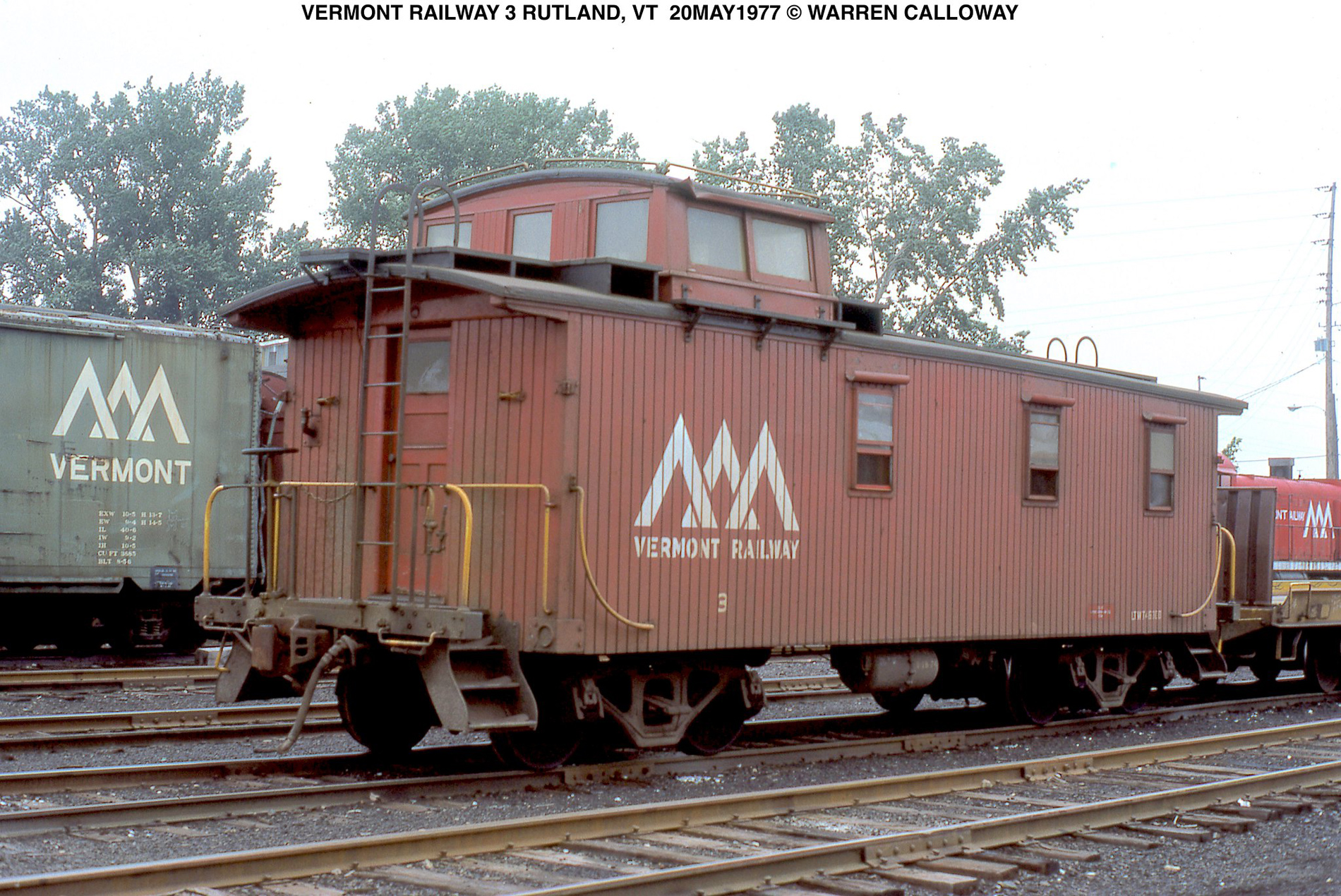 Vermont Railway wooden caboose #3, of Rutland Railroad lineage, is seen here in Rutland, Vermont on May 20, 1977. Warren Calloway photo.
Vermont Railway wooden caboose #3, of Rutland Railroad lineage, is seen here in Rutland, Vermont on May 20, 1977. Warren Calloway photo.While not a
particularly large number the state was once an important agricultural
producer, particularly in milk and related products which sustained the
Rutland for years.
Today, many of the state's secondary and branch lines that served these farming interests have long since been abandoned as it retains just 52% of its original rail infrastructure (which is about average for most states, which have seen similar declines).
Recent Articles
-
Texas Dinner Train Rides At The TSR!
Jan 19, 26 12:30 PM
Today, TSR markets itself as a round-trip, four-hour, 25-mile journey between Palestine and Rusk—an easy day trip (or date-night centerpiece) with just the right amount of history baked in. -
Iowa's Dinner Train Rides In Boone!
Jan 19, 26 12:28 PM
If you’ve ever wished you could pair a leisurely rail journey with a proper sit-down meal—white tablecloths, big windows, and countryside rolling by—the Boone & Scenic Valley Railroad & Museum… -
Ohio Dinner Train Rides At The CVSR!
Jan 19, 26 12:27 PM
While the railroad is well known for daytime sightseeing and seasonal events, one of its most memorable offerings is its evening dining program—an experience that blends vintage passenger-car ambience… -
Missouri's Dinner Train Rides In Branson!
Jan 19, 26 12:21 PM
Nestled in the heart of the Ozarks, the Branson Scenic Railway offers one of the most distinctive rail experiences in the Midwest—pairing classic passenger railroading with sweeping mountain scenery a… -
Virginia Valentine's Train Rides
Jan 19, 26 12:15 PM
If you’ve ever wanted to slow life down to the rhythm of jointed rail—coffee in hand, wide windows framing pastureland, forests, and mountain ridges—the Virginia Scenic Railway (VSR) is built for exac… -
Maryland Valentine's Train Rides
Jan 19, 26 12:12 PM
The Western Maryland Scenic Railroad (WMSR) delivers one of the East’s most “complete” heritage-rail experiences: and also offer their popular dinner train during the Valentine's Day weekend. -
Indiana's Dinner Train Rides In Jasper!
Jan 18, 26 01:54 PM
In the rolling hills of southern Indiana, the Spirit of Jasper offers one of those rare attractions that feels equal parts throwback and treat-yourself night out: a classic excursion train paired with… -
New Mexico's Dinner Train Rides
Jan 18, 26 01:37 PM
If your heart is set on clinking glasses while the desert glows at sunset, you can absolutely do that here—just know which operator offers what, and plan accordingly. -
New Hampshire ~ Murder Mystery ~ Dinner Train Rides
Jan 18, 26 01:10 PM
The state's murder mystery trains stand out as a captivating blend of theatrical drama, exquisite dining, and scenic rail travel. -
New York Valentine's Train Rides
Jan 18, 26 12:32 PM
At its best, the Adirondack Railroad delivers exactly what railfans and casual riders alike hope for: vintage coaches, classic depots, rivers and forests right outside the window. -
Washington Valentine's Train Rides
Jan 18, 26 10:50 AM
Whether you’re a dedicated railfan chasing preserved equipment or a couple looking for a memorable night out, CCR&M offers a “small railroad, big experience” vibe—one that shines brightest on its spec… -
Colorado Valentine's Train Rides
Jan 18, 26 10:49 AM
The Royal Gorge Route Railroad is the kind of trip that feels tailor-made for railfans and casual travelers alike, including during Valentine's weekend. -
Georgia Valentine's Train Rides
Jan 18, 26 10:42 AM
f you’ve ridden the SAM Shortline, it’s easy to think of it purely as a modern-day pleasure train—vintage cars, wide South Georgia skies, and a relaxed pace that feels worlds away from interstates and… -
New Jersey ~ Murder Mystery ~ Dinner Train Rides
Jan 17, 26 01:16 PM
There are currently no murder mystery dinner trains available in New Jersey although until 2023 the Cape May Seashore Lines offered this event. Perhaps they will again soon! -
West Virginia Dinner Train Rides In Elkins!
Jan 17, 26 01:08 PM
The D&GV offers the kind of rail experience that feels purpose-built for railfans and casual travelers. -
Virginia Dinner Train Rides In Staunton!
Jan 17, 26 11:55 AM
If you’ve ever wished you could pair a classic scenic train ride with a genuinely satisfying meal—served at your table while the countryside rolls by—the Virginia Scenic Railway was built for you. -
Florida Easter Train Rides
Jan 17, 26 10:23 AM
The cold weather rarely invades Florida and the state nearly always warm and balmy early spring temperatures. Learn more about where you can find Easter-themed train rides across the Sunshine State. -
Ohio Easter Train Rides
Jan 17, 26 10:13 AM
Ohio is home to several museums and excursion trains preserving the state's rich railroading heritage. A few of these locations host Easter-themed train rides each spring. -
Massachusetts Valentine's Train Rides
Jan 17, 26 09:58 AM
The Cape Cod Central Railroad (CCCR) blends classic New England scenery with heritage equipment, narrated sightseeing, and some of the region’s best-known “rails-and-meals” experiences. -
California Valentine's Train Rides
Jan 17, 26 09:53 AM
Operating out of West Sacramento, this excursion railroad has built a calendar that blends scenery with experiences—wine pours, themed parties, dinner-and-entertainment outings, and seasonal specials… -
South Carolina Dinner Train Rides
Jan 16, 26 11:13 PM
There is only location in the Palmetto State offering a true dinner train experience can be found at the South Carolina Railroad Museum. Learn more here. -
Rhode Island Dinner Train Rides
Jan 16, 26 11:01 PM
Despite its small size, Rhode Island is home to one popular dinner train experience where guests can enjoy the breathtaking views of Aquidneck Island. -
Pennsylvania's Thomas The Train Rides
Jan 16, 26 04:13 PM
"A Day Out With Thomas” train rides offer a unique opportunity for children and their families to engage in a magical and memorable experience, setting the stage for a full day of fun and adventure. -
Illinois's Thomas The Train Rides
Jan 16, 26 02:23 PM
In Illinois, the "A Day Out With Thomas" event offers a unique chance for families to immerse themselves in the enchanting world of Thomas and friends, creating memories that last a lifetime. -
New Jersey's Thomas The Train Rides
Jan 16, 26 02:11 PM
Here's a comprehensive guide to what you can expect at Day Out With Thomas events in New Jersey. -
Texas ~ Murder Mystery ~ Dinner Train Rides
Jan 16, 26 01:54 PM
Here’s a comprehensive look into the world of murder mystery dinner trains in Texas. -
Connecticut ~ Murder Mystery ~ Dinner Train Rides
Jan 16, 26 01:26 PM
All aboard the intrigue express! One location in Connecticut typically offers a unique and thrilling experience for both locals and visitors alike, murder mystery trains. -
New Hampshire Dinner Train Rides In N. Conway!
Jan 16, 26 10:47 AM
Tucked into the heart of New Hampshire’s Mount Washington Valley, the Conway Scenic Railroad is one of New England’s most beloved heritage railways -
Oregon Dinner Train Rides Near Mt. Hood!
Jan 16, 26 10:44 AM
The Mt. Hood Railroad is the moving part of that postcard—a century-old short line that began as a working railroad. -
Maryland's - Wine Tasting - Train Rides
Jan 15, 26 02:59 PM
This article delves into the enchanting world of wine tasting train experiences in Maryland, providing a detailed exploration of their offerings, history, and allure. -
Colorado's - Wine Tasting - Train Rides
Jan 15, 26 02:46 PM
To truly savor these local flavors while soaking in the scenic beauty of Colorado, the concept of wine tasting trains has emerged, offering both locals and tourists a luxurious and immersive indulgenc… -
Iowa ~ Wine Tasting ~ Train Rides
Jan 15, 26 02:36 PM
The state not only boasts a burgeoning wine industry but also offers unique experiences such as wine by rail aboard the Boone & Scenic Valley Railroad. -
Georgia's Wine Train Rides In Cordele!
Jan 15, 26 02:26 PM
While the railroad offers a range of themed trips throughout the year, one of its most crowd-pleasing special events is the Wine & Cheese Train—a short, scenic round trip designed to feel like a t… -
Indiana ~ Murder Mystery ~ Dinner Train Rides
Jan 15, 26 02:22 PM
This piece explores the allure of murder mystery trains and why they are becoming a must-try experience for enthusiasts and casual travelers alike. -
Ohio ~ Murder Mystery ~ Dinner Train Rides
Jan 15, 26 02:10 PM
The murder mystery dinner train rides in Ohio provide an immersive experience that combines fine dining, an engaging narrative, and the beauty of Ohio's landscapes. -
Nevada Dinner Train Rides In Ely!
Jan 15, 26 02:01 PM
If you’ve ever wished you could step through a time portal into the hard-working world of a 1900s short line the Nevada Northern Railway in Ely is about as close as it gets. -
Michigan Dinner Train Rides In Owosso!
Jan 15, 26 09:46 AM
The Steam Railroading Institute is best known as the home of Pere Marquette #1225 and even occasionally hosts a dinner train! -
Arizona's - Wine Tasting - Train Rides
Jan 14, 26 02:04 PM
For those who want to experience the charm of Arizona's wine scene while embracing the romance of rail travel, wine tasting train rides offer a memorable journey through the state's picturesque landsc… -
Arkansas's - Wine Tasting - Train Rides
Jan 14, 26 01:57 PM
This article takes you through the experience of wine tasting train rides in Arkansas, highlighting their offerings, routes, and the delightful blend of history, scenery, and flavor that makes them so… -
Tennessee ~ Murder Mystery ~ Dinner Train Rides
Jan 14, 26 01:42 PM
Amidst the rolling hills and scenic landscapes of Tennessee, an exhilarating and interactive experience awaits those with a taste for mystery and intrigue. -
California ~ Murder Mystery ~ Dinner Train Rides
Jan 14, 26 01:26 PM
When it comes to experiencing the allure of crime-solving sprinkled with delicious dining, California's murder mystery dinner train rides have carved a niche for themselves among both locals and touri… -
Illinois ~ Murder Mystery ~ Dinner Train Rides
Jan 14, 26 01:13 PM
Among Illinois's scenic train rides, one of the most unique and captivating experiences is the murder mystery excursion. -
Vermont's - Murder Mystery - Dinner Train Rides
Jan 14, 26 12:57 PM
There are currently murder mystery dinner trains offered in Vermont but until recently the Champlain Valley Dinner Train offered such a trip! -
Massachusetts Dinner Train Rides On Cape Cod!
Jan 14, 26 12:20 PM
The Cape Cod Central Railroad (CCCR) has carved out a special niche by pairing classic New England scenery with old-school hospitality, including some of the best-known dining train experiences in the… -
Maine Dinner Train Rides In Portland!
Jan 14, 26 11:31 AM
While this isn’t generally a “dinner train” railroad in the traditional sense—no multi-course meal served en route—Maine Narrow Gauge does offer several popular ride experiences where food and drink a… -
Kentucky Dinner Train Rides In Bardstown!
Jan 13, 26 01:14 PM
The essence of My Old Kentucky Dinner Train is part restaurant, part scenic excursion, and part living piece of Kentucky rail history. -
Kansas Dinner Train Rides In Abilene!
Jan 13, 26 12:44 PM
If you’re looking for a heritage railroad that feels authentically Kansas—equal parts prairie scenery, small-town history, and hands-on railroading—the Abilene & Smoky Valley Railroad (A&SV) delivers. -
Michigan ~ Murder Mystery ~ Dinner Train Rides
Jan 13, 26 11:24 AM
Among the lesser-known treasures of this state are the intriguing murder mystery dinner train rides—a perfect blend of suspense, dining, and scenic exploration. -
Virginia's - Murder Mystery - Dinner Train Rides
Jan 13, 26 11:11 AM
Among the state's railroad attractions, murder mystery dinner trains stand out as a captivating fusion of theatrical entertainment, fine dining, and scenic travel. -
Arizona Dinner Train Rides At The Grand Canyon!
Jan 13, 26 10:59 AM
While the Grand Canyon Railway does not offer a true, onboard dinner train experience it does offer several upscale options and off-train dining.

